Beijing Subway
 | |
 | |
| Overview | |
|---|---|
| Owner | Beijing Municipal Government |
| Locale | Beijing |
| Transit type | Rapid transit |
| Number of lines | 18 |
| Number of stations | 334[a] |
| Daily ridership |
8.90 million (2015 daily avg.)[1] 10.0876 million (2014 weekday avg.)[1] 12.69 million (Peak record)[2] |
| Annual ridership | 3.25 billion (2015)[3] |
| Website |
www.bjsubway.com www.mtr.bj.cn/en/ |
| Operation | |
| Began operation | 1 October 1969 |
| Operator(s) |
Beijing Mass Transit Railway Operation Corp., Ltd Beijing MTR Corp. Ltd. |
| Number of vehicles | 4946 Revenue Railcars[3] |
| Technical | |
| System length | 554 km (344 mi)[4] |
| Track gauge | 1,435 mm (4 ft 8 1⁄2 in) (standard gauge) |
| Beijing Subway | |||||||
| Simplified Chinese | 北京地铁 | ||||||
|---|---|---|---|---|---|---|---|
| Traditional Chinese | 北京地鐵 | ||||||
| |||||||
The Beijing Subway is a rapid transit rail network that serves the urban and suburban districts of Beijing municipality. The network has 18 lines, 334 stations[a] and 554 km (344 mi) of track in operation,[4] and is the second longest subway system in the world after the Shanghai Metro. The subway is the world's busiest in annual ridership, with 3.41 billion trips delivered in 2014,[3] averaging 9.2786 million per day, with peak single-day ridership reaching 11.5595 million.[1]
The Beijing Subway opened in 1969 and is the oldest metro system in mainland China. The subway has undergone rapid expansion since 2002, as only two lines were in service before then. The most recent expansion came into effect on December 26, 2015 with the opening of the section of Line 14 from Beijing South Railway Station to Jintailu, Phase II of the Changping Line from Nanshao to Changping Xishankou, Andelibeijie Station on Line 8, and Datunlu East Station on Line 15.[5]
The existing network still cannot adequately meet the city's mass transit needs. Beijing Subway's extensive expansion plans call for 1,050 km (650 mi) of lines by 2020.[6][7]
The Beijing Subway is owned by the city of Beijing and has two operators. The main operator is the wholly state-owned Beijing Mass Transit Railway Operation Corp., which operates 15 lines.[8] The second operator is the Beijing MTR Corp., a public–private joint venture with the Hong Kong MTR and Beijing Capital Group, a state owned enterprise under the Beijing Municipality, which built and manages three of the newer lines (Line 4, Daxing Line and both sections of Line 14) and is also building Line 16.[9]
Fares
Distance-based fare
| Distance-based fare schedule | |
|---|---|
| Fare | Trip distance |
| ¥3 | <6 km |
| ¥4 | 6–12 km |
| ¥5 | 12–22 km |
| ¥6 | 22–32 km |
| ¥7 | 32–52 km |
| ¥8 | 52–72 km |
| ¥9 | 72–92 km |
| ¥10 | 92–112 km |
The Beijing Subway switched from a fixed-fare to a distance-based fare schedule for all lines except the Airport Express on December 28, 2014.[10] Fares start at ¥3 for a trip up to 6 km in distance, with ¥1 added for the next 6 km, for every 10 km thereafter until the trip distance reaches 32 km, and for every 20 km beyond the first 32 km.[10] For example, a 40 km trip would cost ¥7. The Airport Express costs ¥25 per ride.[11] Children below 1.3 metres (51 in) in height ride for free when accompanied by a paying adult.[12] Senior citizens over the age of 65, individuals with physical disabilities, retired revolutionary cadres, police and army veterans who had been wounded in action, military personnel and People's Armed Police can ride the subway for free.[13] Riders can look up fares by checking fare schedules posted in stations, calling the subway hotline 96165, going to the Beijing Subway website, or using the subway's smartphone app.
Fare collection
| Discounts for Yikatong card users | ||
|---|---|---|
| Monthly expenditure |
Net expenditure after credit rebate |
Net discount percentage |
| ¥50 | ¥50 | 0% |
| ¥100 | ¥100 | 0% |
| ¥150 | ¥140 | 6.67% |
| ¥200 | ¥165 | 17.5% |
| ¥250 | ¥190 | 24% |
| ¥300 | ¥215 | 28.3% |
| ¥350 | ¥240 | 31.4% |
| ¥400 | ¥265 | 33.75% |
| ¥450 | ¥315 | 30% |
| ¥500 | ¥365 | 27% |
Riders must insert the ticket or tap the card at the gate both before entering and exiting the station. The subway's fare collection gates accept single-ride tickets and the Yikatong fare card. Riders can purchase tickets and add credit to Yikatong card at ticket counters or vending machines in every station. The Yikatong, also known as the One Card Through Card, is an integrated circuit card that stores credit for the subway, urban and suburban buses and e-money for other purchases.[14] The Yikatong card itself must be purchased at the ticket counter. To enter a station, the Yikatong card must have a minimum balance of ¥3.00.[15]
To prevent fraud, riders are required to complete their journeys within four hours upon entering the subway.[13] If the four-hour limit is exceeded, a surcharge of ¥3 is imposed.[16] Each Yikatong card is allowed to be overdrawn once. The overdrawn amount is deducted when credits are added to the card.[17]
Yikatong card users who spend more than ¥100 on subway fare in a calendar month will receive credits to their card the following month.[10] After reaching ¥100 of spending in one calendar month, 20% of any further spending up to ¥150 will be credited. When spending exceeds ¥150, 50% of any further spending up to ¥250 will be credited.[10] Once expenditures exceed ¥400, further spending will not earn any more credits.[10] The credits are designed to ease commuters' burdens of fare increases.[10]
Previous fare schedules
Prior to the December 28, 2014 fare increase, passengers paid a flat rate of RMB(¥) 2.00 (including unlimited fare-free transfers) for all lines except the Airport Express, which cost ¥25.[18] The flat fare was the lowest among metro systems in China.[19] Before the flat fare schedule was introduced on October 7, 2007, fares ranged from ¥3 to ¥7, depending on the line and number of transfers.
Lines
Beijing Subway lines generally follow the checkerboard layout of the city. Most lines through the urban core (outlined by the Line 10 loop) run parallel or perpendicular to each other and intersect at right angles. Of the 18 lines, 12 are numbered and the other six are named after destinations in the outer suburbs. One line is currently operating in two separate sections.

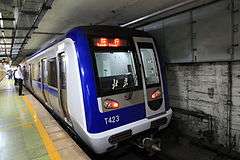
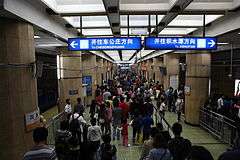
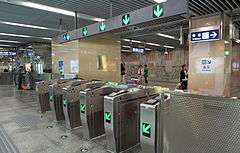

Lines serving the urban core
- Line 1, a straight east-west line underneath Chang'an Avenue, which bisects the city through Tiananmen Square. Line 1 connects major commercial centres, Xidan, Wangfujing, Dongdan and the Beijing CBD.
- Line 2, the inner rectangular loop line traces the Ming-era inner city wall that once surrounded the inner city, and stops at 11 of the wall's former gates (ending in men), now busy intersections, as well as the Beijing Railway Station.[d]
- Line 4, a mainly north-south line running west of city centre with stops at the Summer Palace, Old Summer Palace, Peking and Renmin Universities, Zhongguancun Technology Park, National Library, Beijing Zoo, Xidan and Beijing South Railway Station.
- Line 5, a straight north-south line just east of the city centre. It passes the Temple of Earth, Lama Temple and the Temple of Heaven.
- Line 6, a nearly straight east-west line running parallel and to the north of Line 1. It passes through the city centre north of Beihai Park.
- Line 7, an east-west line running parallel and to the south of Line 1 and Batong Line, from Beijing West Railway Station to Jiaohuachang (Coking Plant).
- Line 8, a north-south line following the city’s central axis from Changping District through Huilongguan and the Olympic Green to Shichahai and Nanluoguxiang inside the Second Ring Road.
- Line 9, a north-south line running west of Line 4 from the National Library through the Military Museum and Beijing West Railway Station to Guogongzhuang, southwest of city centre.
- Line 10, the outer loop line runs underneath or just beyond the Third Ring Road. Apart from the Line 2 loop, which is entirely enclosed within the Line 10 loop, every other line through the urban core intersects with Line 10. In the north, Line 10 traces Beijing's Yuan-era city wall.
- Line 14, operates in two sections: an east-west line from Zhangguozhang to Xiju on Line 10, in the southwestern suburbs and an inverted L-shaped line from the Beijing South Railway Station east to Beijing University of Technology in the southeast before turning due north through the Beijing CBD, Chaoyang Park, Jiuxianqiao, and Wangjing to Shan'gezhuang in Chaoyang District.
Lines to outlying suburbs
The following lines run from the edge of the urban core to outer suburbs beyond the Fifth Ring Road.
- Line 13 arcs across suburbs north of the city and channels commuters to Xizhimen and Dongzhimen, at the northwest and northeast corners of Line 2.
- Line 15 starts from the east of Tsinghua University, passes the Olympic Green and Wangjing, and runs northeast to suburban Shunyi District.
- Batong Line extends Line 1 eastward from Sihui to suburban Tongzhou District.
- Changping Line branches off Line 13 at Xi'erqi and runs north through suburban Changping District. The line passes the Life Sciences Park, Shahe University Park, and the Thirteen Ming Tombs.
- Daxing Line extends Line 4 south to suburban Daxing District.
- Fangshan Line extends Line 9 south from Guogongzhuang to Fangshan District in the southwestern suburbs.
- Yizhuang Line extends from Line 5's southern terminus to the Yizhuang Economic & Technological Development Zone in the southeastern suburbs.
- Airport Express connects the Beijing Capital International Airport, 27 km (17 mi) northeast of the city, with Line 10 at Sanyuanqiao and Lines 2 and 13 at Dongzhimen.
Future lines
The Beijing Subway is expected to reach 1,000 km of lines by the end of 2020.[21] By then public transit mode share of motorized trips will reach 60%, with subway accounting for 62% of all public transit rides.[22] In February 2012, the city government confirmed that six new lines, including Lines 3, 12, 17, 19, and R1 were under planning.[23] Line 17, also known as R2 is planned to run north-south, parallel and to the east of Line 5, from Future Technology City to Yizhuang.[24] Line 19, also known as R3, is planned to run north-south, between Lines 16 and 4.[25] In the latter half of 2015, Lines 3, 12, 17, 19 and the New Airport Line along with the eastern extension of Line 7 were slated to begin construction.[26] By the end of 2015, there were 291 km of track under construction on 15 lines: Line 3, Line 6 (Phase III), Line 7 (Phase II), Line 8 (Phase III), Line 12, Line 14 (middle-west section), Line 16, Line 17, Line 19, New-Airport Express, Airport Express (Phase II), Fangshan Line (Phase II), Yanfang Line, Mentougou Line, and the West Suburban Line.[27] The new lines will significantly expand the subway's coverage, especially south and west of the city. Line 16 will run parallel and to the west of Line 4. Line 14's two sections will be connected into an inverted L-shaped line that pivots in the southeast. The Fangshan Line will be extended to the Third Ring Road and be connected with Lines 10 and 16.[28] The Western Suburban and Yanfang Lines will link outlying districts to the Beijing Subway. In January 2010, the government of Shijingshan District disclosed plans for a Line 11 in western Beijing that would traverse the Beijing Capital Steel complex and intersect with Lines 1 and 4.[29] Construction was set to begin in 2020.
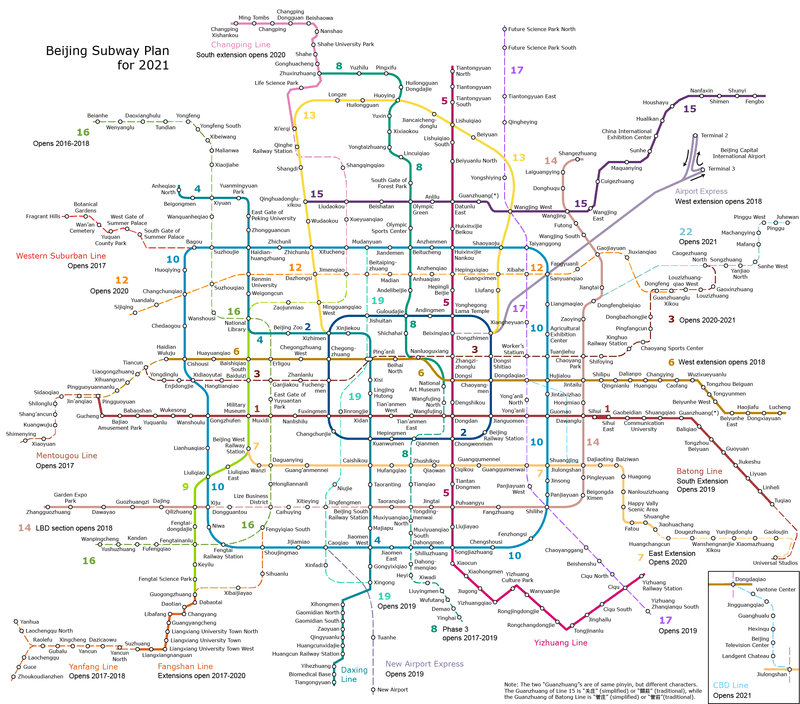
| Details of future subway lines | |||||||||
|---|---|---|---|---|---|---|---|---|---|
| Planned opening |
Line | Phase & Section | Terminals (District) |
Route Description | Construction since |
Length (km) |
Stations | Refs | |
| 2016 | Line 16 | Shanhou Line | Beianhe (Haidian) |
Xiyuan Station (Haidian) |
Northern section of Line 16 formerly known as Haidian Shanhou Line | 2013 | 19.6 | 10 | [30][31][31][32] |
| 2017 | Line 8 | Phase III South Section | Zhushikou (Dongcheng) |
Yinghaizhen (Daxing) |
Southern section of a new north-south axis to Daxing District. | 2013 | 13 | [30][33] | |
| Fangshan Line | West extension | Yancun North (Fangshan) |
Suzhuang (Fangshan) |
connects Fangshan Line to Yanfang Line | 2014 | 2.2 | 1 | [34] | |
| Yanfang Line | Main Line | Yancun North (Fangshan) |
Yanhua | extends Fangshan Line west to Yanshan Sinopec Center. | 2013 | 14.4 | 8 | [30][31][34][35][36] | |
| Western Suburban Line |
Bagou (Haidian) |
Fragrant Hills (Haidian) |
light rail or tram from the northwest corner of Line 10 to the Fragrant Hills. | 2010 | 9.1 | 7 | [31][35][37][38][39] | ||
| Line 16 | Xiyuan Station (Haidian) |
Wanping (Fengtai) |
Urban Section | 2013 | 30.1 | 19 | [40] | ||
| 2018 | Airport Express | Western Extension | Dongzhimen (Dongcheng) |
Beixinqiao (Dongcheng) |
Extension to Line 5 | 2015 | 1.9 | 1 | [41][42] |
| Line 6 | Phase III | Jin'anqiao | Haidian Wuluju | extends Line 6 east to Shijingshan District | 2014 | 10.29 | 6 | ||
| 2019 | Line 8 | Phase III North Section | Museum of Art (Dongcheng) |
Zhushikou (Dongcheng) |
Central section of Line 8 through Qianmen and Yongdingmen completing the central north-south axis. | 2013 | 3 | [43][44] | |
| Line 14 | Lize Section | You'anmenwai (Fengtai) |
Xiju (Fengtai) |
Completes Line 14 | 4.3 | 4 | [45] | ||
| Line 17 (R2) | Wangjing West (Chaoyang) |
Yizhuang Railway Station (Tongzhou) |
North-south express line via Dongdaqiao, Yonganli and Shilihe | 49.7 | 20 | [24][46][47] | |||
| Fangshan Line | North extension | Guogongzhuang (Fengtai) |
Fengyiqiaonan (Fengtai) |
connects Fangshan Line to Line 16 | 2016 | 4.6 | 4 | [34][48] | |
| New Airport Line | Mudanyuan | Beijing Daxing International Airport | Connecting to a proposed new Beijing Airport | 59.2 | 5 | .[37][47][49][50][51] | |||
| Line 19 (R3) | 1st Phase | Xingong (Fengtai) |
Mudanyuan (Haidian) |
North South express line | 2015 | 22.4 | 10 | [47] | |
| Before 2020 | Line 3 | Tiancun | Dongba | East-west line parallel to line 6 | 37 | 29 | |||
| Line 7 | Jiaohuachang | Universal Studios | Eastern extension | 17.2 | 7 | [47] | |||
| Line 9 | Phase 2 North Extension | National Library | Xi'erqi | Extends Line 9 north | 17.1 | 10 | [52] | ||
| Line 12 | Tiancun | Jiuxianqiao | Following the North Third Ring Road | 24 | 20 | [47] | |||
| Line 18 (R1) | Shang'ancun (Mentougou) |
Songzhuang (Tongzhou) |
An express line, running under Line 1 | 55 | 15 | ||||
Monorail
In 2014, Beijing planning authorities assessed mass transit monorail lines for areas of the city in which subway construction or operation is difficult.[53] Straddle beam monorail trains have lower transport capacity and operating speed (60 km/h) than conventional subways, but are quieter to operate, have smaller turning radius and better climbing capability, and cost only one-third to one-half of subways to build.[53][54] According to the initial environmental assessment report by the Chinese Academy of Rail Sciences, a Yuquan Lu Line was planned to have 21 stations over 24.966 km in western Beijing.[55] The line was to begin construction in 2014 and would take two years to complete.[53] A Dongsihuan Line (named for the Eastern Fourth Ring Road it was to follow) was planned to have 21 stations over 36 km.[54][56] In early 2015, plans for both monorail lines were shelved indefinitely, due to resident opposition.[57] Both lines remain on the city's 2020 transportation plan, and may be built as conventional below-ground subway lines.
CBD Automatic People Mover
In August 2015, planning authorities proposed an underground automatic people mover (APM) line through the Central Business District (CBD).[58] The line would run 4.9 km and have eight stations from Dongdaqiao on Line 6 to Jiulongshan on Line 7, and has been incorporated into the 2020 Subway Plan.[58]
History

1953–1965: origins
The subway was proposed in September 1953 by the city's planning committee and experts from the Soviet Union.[59] After the end of the Korean War, Chinese leaders turned their attention to domestic reconstruction. They were keen to expand Beijing's mass transit capacity but also valued the subway as an asset for civil defense. They studied the use of the Moscow Metro to protect civilians, move troops and headquarter military command posts during the Battle of Moscow, and planned the Beijing Subway for both civilian and military use.[59]
The Chinese lacked expertise in building subways and drew heavily on Soviet and East German technical assistance. In 1954, a delegation of Soviet engineers, including some who had built the Moscow Metro, was invited to plan the subway in Beijing.[59] From 1953 to 1960, several thousand Chinese students were sent to the Soviet Union to study subway construction.[59] An early plan unveiled in 1957 called for one ring route and six other lines with 114 stations and 172 km (107 mi) of track.[59] Two routes vied for the first to be built. One ran east-west from Wukesong to Hongmiao, underneath Changan Avenue. The other ran north-south from the Summer Palace to Zhongshan Park, via Xizhimen and Xisi. The former was chosen due to more favorable geological foundation and greater number of government bureaus served. The second route would not be built until construction on Line 4 began forty years later.
The deterioration of relations between China and Soviet Union disrupted subway planning. Soviet experts began to leave in 1960, and were completely withdrawn by 1963.[60] In 1961, the entire project was halted temporarily due to severe hardships caused by the Great Leap Forward. Eventually, planning work resumed. The route of the initial line was shifted westward to create an underground conduit to move personnel from the heart of the capital to the Western Hills. On February 4, 1965, Chairman Mao Zedong personally approved the project.[61]
1965–1981: the slow beginning

Construction began on July 1, 1965, at a ceremony attended by national leaders including Zhu De, Deng Xiaoping, and mayor Peng Zhen.[62] The most controversial outcome of the initial subway line was the demolition of the Beijing's historic inner city wall to make way for the subway. Construction plans for the subway from Fuxingmen to the Beijing Railway Station called for the removal of the wall, as well as the gates and archery towers at Hepingmen, Qianmen, and Chongwenmen. Leading architect Liang Sicheng argued for protecting the wall as a landmark of the ancient capital. Chairman Mao favored demolishing the wall over demolishing homes. In the end, Premier Zhou Enlai managed to preserve several walls and gates, such as the Qianmen gate and its arrow tower by slightly altering the course of the subway.[63]




The initial line was completed and began trial operations in time to mark the 20th anniversary of the founding of the People's Republic on October 1, 1969.[61][64] It ran 21 km (13 mi) from the army barracks at Fushouling to the Beijing Railway Station and had 16 stations.[61] This line forms parts of present-day Lines 1 and 2. It was the first subway to be built in China, and predates the metros of Hong Kong, Seoul, Singapore, San Francisco, and Washington, D.C., but technical problems would plague the project for the next decade.
.jpg)


Initially, the subway hosted guest visits.[61] On November 11, 1969, an electrical fire killed three people, injured over 100 and destroyed two cars.[61] Premier Zhou Enlai placed the subway under the control of the People's Liberation Army in early 1970, but reliability problems persisted.[61]
On January 15, 1971, the initial line began operation on a trial basis between the Beijing Railway Station and Gongzhufen.[65] Single ride fare was set at ¥0.10 and only members of the public with credential letters from their work units could purchase tickets.[65] The line was 10.7 km in length, had 10 stations and operated more than 60 train trips per day with a minimum wait time of 14 minutes.[65] On August 15, the initial line was extended to Yuquan Lu and had 13 stations over 15.6 km.[65] On November 7, the line was extended again, to Gucheng Lu, and had 16 stations over 22.87 km.[65] The number of trains per day rose to 100. Overall, the line delivered 8.28 million rides in 1971, averaging 28,000 riders per day.[65]
From 1971 to 1975, the subway was shut down for 398 days for political reasons.[e] On December 27, 1972, the riders no longer needed to present credential letters to purchase tickets.[65] In 1972, the subway delivered 15 million rides and averaged 41,000 riders per day.[65] In 1973, the line was extended to Pingguoyuan and reached 23.6 km in length with 17 stations and 132 train trips per day.[65] The line delivered 11 million rides in 1973, averaging 54,000 riders per day.[65]
Despite its return to civilian control in 1976, the subway remained prone to closures due to fires, flooding, and accidents. Annual ridership grew from 22.2 million in 1976 and 28.4 million in 1977 to 30.9 million in 1978, and 55.2 million in 1980.[65]
1981–2000: two lines for two decades
On April 20, 1981, the Beijing Subway Company, then a subsidiary of the Beijing Public Transportation Company, was organized to take over subway operations.[66] On September 15, 1981, the initial line passed its final inspections, and was handed over to the Beijing Subway Company, ending a decade of trial operations.[66] It had 19 stations and ran 27.6 kilometres (17.1 miles) from Fushouling in the Western Hills to the Beijing Railway Station.[66] Investment in the project totaled ¥706 million. Annual ridership rose from 64.7 million in 1981 and 72.5 million in 1982 to 82 million in 1983.[66]

On September 20, 1984, a second line was opened to the public.[66] This horseshoe-shaped line was created from the eastern half of the initial line and corresponds to the southern half of the present-day Line 2.[66] It ran 16.1 km (10.0 mi) from Fuxingmen to Jianguomen with 16 stations.[66] Ridership reached 105 million in 1985.[66]
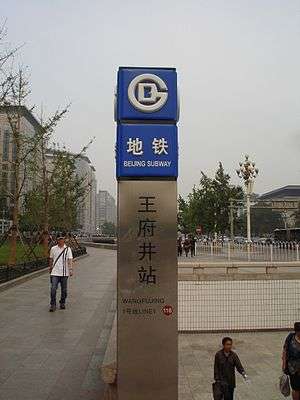
On December 28, 1987, the two existing lines were reconfigured into Lines 1, which ran from Pingguoyuan to Fuxingmen and Line 2, in its current loop, tracing the Ming city wall.[66] Fares doubled to ¥0.20 for single-line rides and ¥0.30 for rides with transfers.[66] Ridership reached 307 million in 1988.[66] The subway was closed from June 3–4, 1989 during the suppression of the Tiananmen Square demonstrations. In 1990, the subway carried more than one million riders per day for the first time, as total ridership reached 381 million.[66] After a fare hike to ¥0.50 in 1991, annual ridership declined slightly to 371 million.
On January 26, 1991, planning began on the eastward extension of Line 1 under Chang'an Avenue from Fuxingmen.[67] The project was funded by a 19.2 billion yen low-interest development assistance loan from Japan.[67] Construction began on the eastern extension on June 24, 1992, and the Xidan station opened on December 12, 1992.[67] The remaining extension to Sihui East was completed on September 28, 1999.[68] National leaders Wen Jiabao, Jia Qinglin, Yu Zhengsheng and mayor Liu Qi were on hand to mark the occasion.[68] The full-length of Line 1 became operational on June 28, 2000.[69]
Despite little track expansion in the early 1990s, ridership grew rapidly to reach a record high of 558 million in 1995, but fell to 444 million the next year when fares rose from ¥0.50 to ¥2.00. After fares rose again to ¥3.00 in 2000, annual ridership fell to 434 million from 481 million in 1999.[69]
2001–2008: planning for the Olympics
In the summer of 2001, the city won the bid to host the 2008 Summer Olympics and accelerated plans to expand the subway. From 2002 to 2008, the city planned to invest ¥63.8 billion (US$7.69 billion) in subway projects. Work on Line 5 had already begun on September 25, 2000.[70] Land clearing for Lines 4 and 10 began in November 2003 and construction commenced by the end of the year.[71] Most new subway construction projects were funded by loans from the Big Four state banks. Line 4 was funded by the Beijing MTR Corporation, a joint-venture with the Hong Kong MTR.[72] To achieve plans for 19 lines and 561 km (349 mi) by 2015, the city planned to invest a total of ¥200 billion ($29.2 billion).[73]


The next additions to the subway were surface commuter lines that linked to the north and east of the city. Line 13, a half loop that links the northern suburbs, first opened on the western half from Huilongguan to Xizhimen on September 28, 2002 and the entire line became operational on January 28, 2003.[74] Batong Line, built as an extension to Line 1 to Tongzhou district, was opened as a separate line on December 27, 2003.[75] Work on these two lines had begun respectively in December 1999 and 2000.[76] Ridership hit 607 million in 2004.
Line 5 came into operation on October 7, 2007. It was the city's first north-south line, extending from the Songjiazhuang in the south to Tiantongyuan in the north. On the same day, subway fares were reduced from between ¥3 and ¥7 per trip, depending on the line and number of transfers, to a single flat fare of ¥2 with unlimited transfers. The lower fare policy caused the Beijing Subway to run a deficit of ¥600 million in 2007, which was expected to widen to ¥1 billion in 2008.[73] The Beijing municipal government covered these deficits to encourage mass transit use, and reduce traffic congestion and air pollution. On a total of 655 million rides delivered in 2007, the government's subsidy averaged ¥0.92 per ride.[77]
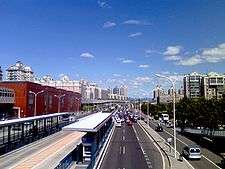
.jpg)
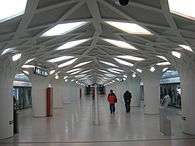
In the summer of 2008, in anticipation of the Summer Olympic Games, three new lines—Line 10, the Olympic Branch Line and the Airport Express—opened on July 19 for trial operation.[78] The use of paper tickets, hand checked by clerks for 38 years, was discontinued and replaced by electronic tickets that are scanned by automatic fare collection machines upon entry and exit of the subway. Stations are outfitted with touch screen vending machines that sell single-ride tickets and multiple-ride Yikatong fare cards. The subway set a daily ridership record of 4.92 million on August 22, 2008, the day of the Games' closing ceremony[79] In 2008, total ridership rose by 75% to 1.2 billion.[80]
2008–present: rapid expansion
After the Chinese government announced a ¥4 trillion economic stimulus package in November 2008, the Beijing urban planning commission further expedited subway building plans, especially for elevated lines to suburban districts that are cheaper to build. In December 2008, the commission moved completion dates of the Yizhuang and Daxing Lines to 2010 from 2012, finalized the route of the Fangshan Line, and unveiled the Changping and Western Suburban Lines.[81]


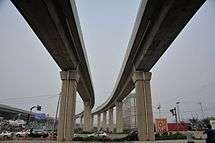
Line 4 started operation on September 28, 2009, bringing subway service to much of western Beijing.[82] It is managed by the MTR Corporation through a joint venture with the city. In 2009, the subway delivered 1.457 billion rides,[83] 19.24% of mass transit trips in Beijing.[84]
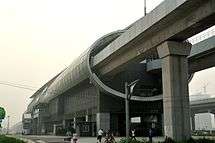
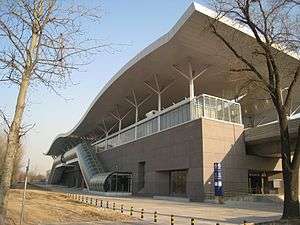
In 2010, Beijing's worsening traffic congestion prompted city planners to move the construction of several lines from the 13th Five Year Plan to the 12th Five Year Plan. This means Lines 8 (Phase III), 3, 12, 16, the Yanfang Line, as well as additional lines to suburban districts of Changping, Tiantongyuan, and Haidian were to begin construction before 2015.[85] Previously, Lines 3, 11, 12 and 16 were being planned for the more distant future.[86][87] On December 30, 2010, five suburban lines: Lines 15 (Phase I from Wangjing West to Houshayu except Wangjing East Station), Changping, Fangshan (except Guogongzhuang Station), Yizhuang (except Yizhuang Railway Station), and Daxing, commenced operation.[88] The addition of 108 km (67 mi) of track, a nearly 50% increase, made the subway the fourth longest metro in the world. One year later, on December 31, 2011, the subway surpassed the New York City Subway to become the third longest metro in revenue track length with the extension of Line 8 north from the Olympic Green to Huilongguan, the opening of Line 9 in southwest Beijing from Beijing West Railway Station to Guogongzhuang (except Fengtai Dongdajie Station, which opened on October 12, 2012), the extension of the Fangshan Line to Guogongzhuang, and the extension of Line 15 from Houshayu to Fengbo in central Shunyi.[89] In the same year, the Beijing goverment unveiled an ambitious expansion plan envisioning the subway network to reach a track density of 0.51 km per km2 (0.82 mi per sq. mi.) inside the Fifth Ring Road where residents would on average have to walk 1 km (0.62 mi) to the nearest subway station.[90] Ridership reached 2.18 billion in 2011.

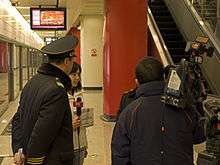
On December 30, 2012, Line 6 (Phase I from Haidian Wuluju to Caofang), the extension of Line 8 from Beitucheng south to Gulou Dajie (except Andelibeijie Station), the remainder of Line 9 (except Military Museum Station) and the remainder of the Line 10 loop (except the Xiju-Shoujingmao section and Jiaomen East Station) entered service. The addition of 69.8 km (43 mi) of track increased the network length to 442 km (275 mi) and allowed the subway to overtake the Shanghai Metro, for several months, as the world’s longest metro.[91] The subway delivered 2.46 billion rides in 2012.[92]
On May 5, 2013, the Line 10 loop was completed with the opening of the Xiju-Shoujingmao section and the Jiaomen East Station.[93] The 57 km (35 mi) loop line became the longest underground subway loop in the world.[93] On the same day, the first section of Line 14 from Zhangguozhuang to Xiju also entered operation, ahead of the opening of the Ninth China International Garden Expo in Fengtai District.[93] The subway's total length reached 456 km (283 mi).[93]
On December 28, 2013, two sections were added to Line 8, which extended the line north to Zhuxinzhuang and south to Nanluoguxiang.[94] In 2013, the subway delivered 3.209 billion rides, an increase of 30% from the year before.[95]
On December 28, 2014, the subway network expanded by 62.2 km (38.6 mi) to 18 lines and 527 km (327 mi) with the opening of Line 7, the eastern extension of line 6 (from Caofang to Lucheng), the eastern section of line 14 (from Jintailu to Shan'gezhuang), and the western extension of line 15 (from Wangjing West to Qinghuadonglu Xikou).[96][97] At the same time, the ¥2 flat-rate fare was replaced with a variable-rate fare (a minimum of ¥3), to cover operation costs.[98][98] In 2014, the subway delivered 3.387 billion rides, an increase of 5.68% from the year before.[3] Average daily and weekday ridership also set new highs of 9.2786 million and 10.0876 million, respectively.[1]
From 2007 to 2014, the cost of subway construction in Beijing rose sharply from ¥0.571 billion per km to ¥1.007 billion per km.[99][100] The cost includes land acquisition, compensation to relocate residents and firms, actual construction costs and equipment purchase. In 2014, city budgeted ¥15.5 billion for subway construction, and the remainder of subway building costs was financed by the Beijing Infrastructure Investment Co. LTD, a city-owned investment firm.[99]
On December 26, 2015, the subway network expanded to 554 km (344 mi) with the opening of the section of Line 14 from Beijing South Railway Station to Jintailu (11 stations; 16.6 km (10.3 mi)), Phase II of the Changping Line from Nanshao to Changping Xishankou (5 stations; 10.6 km (6.6 mi)), Andelibeijie Station on Line 8, and Datunlu East Station on Line 15.[5] Ridership in 2015 fell by 4% to 3.25 billion due to a fare increase from a flat fare back to a distance based fare.[3]
Ridership
| Average Daily Ridership | ||||||||||||||||||||||||||||||||||||||||||||||||||||||||||||||||||||||||||||||||||||||||||||||||||||||||||||||||||||||||||||||||||||||||||||||||||||||
|---|---|---|---|---|---|---|---|---|---|---|---|---|---|---|---|---|---|---|---|---|---|---|---|---|---|---|---|---|---|---|---|---|---|---|---|---|---|---|---|---|---|---|---|---|---|---|---|---|---|---|---|---|---|---|---|---|---|---|---|---|---|---|---|---|---|---|---|---|---|---|---|---|---|---|---|---|---|---|---|---|---|---|---|---|---|---|---|---|---|---|---|---|---|---|---|---|---|---|---|---|---|---|---|---|---|---|---|---|---|---|---|---|---|---|---|---|---|---|---|---|---|---|---|---|---|---|---|---|---|---|---|---|---|---|---|---|---|---|---|---|---|---|---|---|---|---|---|---|---|---|
|
|
|
| |||||||||||||||||||||||||||||||||||||||||||||||||||||||||||||||||||||||||||||||||||||||||||||||||||||||||||||||||||||||||||||||||||||||||||||||||||
| Source: 北京地铁大事记回顾 1965-2006 • 北京市2010年暨"十一五"期间国民经济和社会发展统计公报 • 北京市2011年国民经济和社会发展统计公报 • 北京市2012年国民经济和社会发展统计公报 • 北京市2013年国民经济和社会发展统计公报 [1] | ||||||||||||||||||||||||||||||||||||||||||||||||||||||||||||||||||||||||||||||||||||||||||||||||||||||||||||||||||||||||||||||||||||||||||||||||||||||
Rolling stock
All subway trains run on 1,435 millimetres (56.5 in) standard gauge rail and draw power from the 750 V DC third rail, with the exception of trains on Lines 6 and 14, which use overhead wires. All lines operate 6-car train sets with a maximum speed of 80 km/h (50 mph), except Lines 6 and 7, which use 8-car sets that can reach 100 km/h (62 mph), and the Airport Express, which has 4-car sets with a maximum speed of 110 km/h (68 mph).[101][102] Line 14 trains feature wide-bodied Type-A cars that have a designed capacity of 430 passengers per car, 30% greater than Type-B cars with 310 passengers per car.[103] Type-B cars are used on all other lines except the Airport Express, whose cars can seat 230 passengers.
Until 2003 nearly all trains were manufactured by the Changchun Railway Vehicles Company Ltd., now a subsidiary of the China CNR Corporation.[104] Currently, all trains on Lines 2, 5, 8, 10, 13, Airport Express and older models on Line 1 are made by Changchun RVC, which is under contract to supply trains for Lines Yizhuang, 9 and 10 (Phase II).[102][105] The newest Line 1 trains and those on Lines 4, 8, Batong, Changping and Daxing are made by Qingdao Sifang Locomotive & Rolling Stock Co., a subsidiary of China South Locomotive and Rolling Stock Industry Corp..[106][107]
The Beijing Subway Rolling Stock Equipment Co. Ltd., a wholly owned subsidiary of the Beijing Mass Transit Railway Operation Corp. Ltd., provides local assemblage, maintenance and repair services.
System upgrades
Capacity
With new lines drawing more riders to the network, the subway has experienced severe overcrowding, especially during the rush hour.[108] As of 2015, significant sections of Lines 1, 4 - Daxing, 5, 10,[109] 13, Batong and Changping are officially over capacity during rush hour.[110] In short term response, the subway upgraded signal equipment to increase the frequency of trains which added additional capacity to the subway lines. Average headways has been reduced to 2 min. on Lines 2, 4, and 10;[111][112][113] 2 min. 05 sec. on Line 1;[114][115] 2 min. 15 sec. on Lines 5[116] 3 min. on Lines 13 and Batong; 3 min. 30 sec. on Line 8;[117] and 15 min. on the Airport Express.[118]
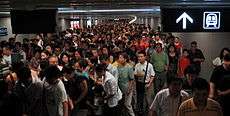
Lines 13 and Batong have converted 4-car to 6-car trains.[119][120] Lines 6[121] and 7 have longer platforms that can accommodate 8-car B size trains,[122] while line 14 uses high capacity wide-body A size trains in 6 car sets.[123][124] New lines that cross the city center such as Lines 3, 11, 12, 16,[125] 17 and 19, now under construction, will adopt high capcity 8-car A size trains with a 70 percent increase in capcity over older lines.[121][126] When completed these lines are expected to greatly relieve overcrowding in the exsisting network.
Despite these efforts, during the morning rush hour, conductors at line terminals and other busy stations must routinely restrict the number of passengers who can board each train to prevent the train from becoming too crowded for passengers waiting at other stations down the line.[127] As of August 31, 2011, 25 stations mainly on Lines 1, 5, 13, and Batong have imposed such restrictions.[128] Some of these stations have built queuing lines outside the stations to manage the flow of waiting passengers.[129] By January 7, 2013, 41 stations on Lines 1, 2, 5, 13, Batong, and Changping had instituted passenger flow restrictions during the morning rush hour.[130] The number of stations with passenger flow restrictions reached 75 in April 2016, mostly affecting Lines 1, 5, 6, 10, 13, Batong, and Changping.[131]
Transfers

Interchange stations that permit transfers across two or more subway lines receive heavy traffic passenger flow. The older interchange stations are notorious for lengthy transfer corridors and slow transfers during peak hours. The average transfer distance at older interchange stations is 128 meters[132] The transfer between Lines 2 and 13 at Xizhimen was over 200 meters long and required 15 minutes to complete during rush hours.[133] In 2011, this station was rebuilt to reduce the transfer distance.[134] There are plans to rebuild other interchange stations such as Dongzhimen.[132]
In newer interchange stations, which are designed to permit more efficient transfers, the average transfer distance is 63 meters.[132] Many of the newer interchange stations including Guogongzhuang Station (Lines 9 and Fangshan), Nanluoguxiang (Lines 8 and 6), Zhuxinzhuang (Changping and Line 8), Beijing West Station (Lines 9 and 7), and National Library (Lines 9 and 4) feature cross platform transfers.[135] Nevertheless, longer transfer corridors must still be used when the alignment of the lines do not permit cross-platform transfer.[136] The transfer corridors between Lines 1 and 9 at the Military Museum, which opened on December 23, 2013, are 160 m in one direction and just under 300 m in the other.[137]
Cellular network coverage
Mobile phones can currently be used throughout, except in the tunnels between stations on Lines 1 and 2. There are plans for all lines and stations to have cellular coverage.[138]
Accessibility
Each station is equipped with ramps, lifts, or elevators to facilitate wheelchair access.[139][140] Newer model train cars now provide space to accommodate wheelchairs.[141] Automated audio announcements for incoming trains are available in all lines except for Line 1. On all lines, station names are announced in Mandarin Chinese and English.
Information hotline and Android app
The Beijing Subway telephone hotline was initiated on the eve of the 2008 Summer Olympic Games to provide traveler information, receive complaints and suggestions, and file lost and found reports.[142] The hotline combined the nine public service telephones of various subway departments.[143] On December 29, 2013, the hotline number was switched from (010)-6834-5678 to (010)-96165 for abbreviated dialing.[144] In December 2014, the hotline began offering fare information, as the subway switched to distance-based fare.[11] The hotline has staffed service from 5 am to midnight and has automated service during unstaffed hours.[142]
The Beijing Subway has an official Android-based mobile application and a number of third-party apps.
Automatic fare collection
Each station has two to 15 ticket vending machines.[145] Ticket vending machines on Line 4, 5, 6, 8, 10 and 14 and several on Line 1 and 2 can add credit to Yikatong cards.[146]
Safety
Passenger searches
To ensure public safety during the 2008 Summer Olympic and Paralympic Games, the subway initiated a three-month heightened security program from June 29 to September 20, 2008. Riders were subject to searches of their persons and belongings at all stations by security inspectors using metal detectors, X-Ray machines and sniffer dogs. Items banned from public transportation such as "guns, ammunition, knives, explosives, flammable and radioactive materials, and toxic chemicals" were subject to confiscation.[147] The security program was reinstituted during the 2009 New Year Holiday[148] and has since been made permanent through regulations enacted in February 2009.[149] Only bags are generally X-rayed (as of 2012), riders are checked only occasionally.
Emergency planning
After witnessing several serious subway accidents in South Korea (e.g. Daegu subway fire in February 2003), the subway removed all shops and vendors from the inside of stations and installed self-illuminating exit signs to facilitate emergency evacuation. The popular underground mall at Xidan station was closed.
Accidents
The subway was plagued by numerous accidents in its early years, including a fire in 1969 that killed six people and injured over 200.[150] But its operations have improved dramatically and there have been few reported accidents in recent years. Most of the reported fatalities on the subway are the result of suicides.[151] Authorities have responded by installing doors on platforms of newer lines.
There have been several reported fatal incidents at subway construction sites in recent years. On October 8, 2003, the collapse of steel beams at the construction site of Line 5's Chongwenmen Station killed three workers and injured one.[152] On March 29, 2007, the construction site at the Suzhoujie Station on Line 10 collapsed, burying six workers. On June 6, 2008, prior to the opening of Line 10, a worker was crushed to death inside an escalator in Zhichunlu Station when an intern turned on the moving staircase.[153] On July 14, 2010, two workers were killed and eight were injured at the construction site of Line 15's Shunyi Station when the steel support structure collapsed on them.[154] On September 17, 2010, Line 9 tunnels under construction beneath Yuyuantan Lake were flooded, killing one worker.[155] A city official who oversaw waterworks contracts at the site was convicted of corruption and given a death sentence with reprieve.[155] On June 1, 2011, one worker was killed when a section of Line 6 under construction in Xicheng District near Pinganli collapsed.[156] A collapse of an escalator at the Beijing Zoo Station on July 5, 2011, caused the death of one 13-year-old boy and injuries to 28 others.[157]
On May 4, 2013, a train derailed when it overran a section of track on Line 4. The section was not open to the public and was undergoing testing. There were no injuries.[158]
On November 6, 2014, a woman was killed when she tried to board the train at Huixinxijie Nankou Station on Beijing Subway's Line 5. She became trapped between the train door and the platform edge door and was crushed to death by the departing train. The accident happened on the second day of APEC China 2014 meetings in the city during which the municipal government has banned cars from the roads on alternate days to ease congestion and reduce pollution during the summit – measures which the capital’s transport authorities have estimated would lead to an extra one million passengers on the subway every day.[159]
Subway culture
Logo
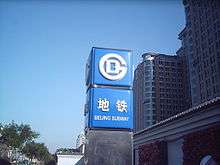
The subway's logo, a capital letter "G" encircling a capital letter "D" with the letter "B" silhouetted inside the letter D, was designed by Zhang Lide, a subway employee, and officially designated in April 1984.[160] The letters B, G, and D form the abbreviation for Běijīng gāosù diànchē or "Beijing high-speed electric carriage".
Subway Culture Park
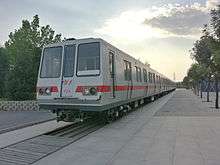
The Beijing Subway Culture Park, located near Xihongmen in Daxing District, opened in 2010 to commemorate the 40-year history of the Beijing Subway.[161] The 19 ha (47 acres) park was built using dirt and debris removed from the construction of the Daxing Line and contains old rolling stock, sculpture, and informational displays.[161] Admission to the park is free.
Beijing Suburban Railway
The Beijing Suburban Railway, a suburban commuter train service, is managed separately from the Beijing Subway. The two systems, although complementary, are not related to each other operationally. The Beijing Suburban Railway has a different fare structure, and is run as part of the Beijing Railway Bureau.
Six "S"-numbered lines have been planned.[162] Line S2, opened August 6, 2008, runs from the Beijing North Railway Station to Yanqing County, and provides direct urban rail access to the Great Wall at Badaling.[163] Connections to the Beijing Subway are available from Beijing North Station, which is connected to Xizhimen Subway Station (Subway Lines 2, 4, 13).
See also
Notes
- a. ^ As of December 26, 2015, the number of unique stations in operation is 278. The unique station count treats the multiple platforms of a station complex as one station. If each station complex's platforms are counted as separate stations, then the total number of stations in operation as of December 26, 2015 would be 334. The unique station count of 278 excludes: the Erligou, Tongyunmen and Beiyunhe East Stations on Line 6; the Shuangjing and Fatou Stations on Line 7; the National Art Museum Station on Line 8; the Taoranqiao, Pingleyuan, Chaoyang Park and Gaojiayuan Stations on Line 14; the Wangjing East Station on Line 15; and the Yizhuang Railway Station on the Yizhuang Line, which were not in use as of December 26, 2015. Also excluded are the three restricted stations of Line 1, which are no longer used. The total station count of 334 excludes the stations listed above and treats the Gongyixiqiao Station as two stations, as the southern terminus for Line 4 and northern terminus for the Daxing Line, even though through-train service have effectively transformed the two lines into a single line for which the Gongyixiqiao Station is (usually) not a terminus but a single station.
- b. ^ With the opening of the Daxing Line on December 30, 2010 the Beijing MTR Corporation operates service on Lines 4 and Daxing as follows:[164][165]
- A loop that covers both lines, from Anheqiao North, the northern terminus of Line 4, to Tiangongyuan, the southern terminus of the Daxing Line.
- A loop that covers Line 4 plus one stop on the Daxing Line, from Anheqiao North to Xingong, the northernmost stop on the Daxing Line. Travelers wishing to proceed further south on the Daxing Line have to switch to a south-bound full-route train.
- c. ^ The subway operated throughout the night from Aug. 8-9, 2008 to accommodate the Opening Ceremonies of the Olympic Games, and is extending evening operations of all lines by one to three hours (to 1-2 a.m.) through the duration of the Games.[166]
- d. ^ There is no subway stop at the 12th gate, Deshengmen, between Jishuitan Station and Gulou Dajie Station.
- e. ^ From August 12, 1973 to June 30, 1974 and in January 1975, the subway was closed due to defense mobilization.[167] It was closed from September 13 to November 6, 1971 in the aftermath of the Lin Biao Incident and on September 18, 1976 after the death of Chairman Mao.[167]
- f. ^ As of December 26, 2015, Line 14 has two sections in operation—from Zhangguozhuang to Xiju in the west and Beijing South Railway Station to Shan'gezhuang in the east. The two sections operate separately but will eventually be connected and is therefore counted as a single line.
References
- 1 2 3 4 5 "北京市2015年暨"十二五"时期国民经济和社会发展统计公报". 北京市统计局 国家统计局北京调查总队. 2016-02-15. Retrieved 2015-02-18.
- ↑ "北京地铁全网客流再创历史纪录 逼近1270万". 中国新闻社. May 1, 2016. Retrieved 2016-05-01.
- 1 2 3 4 5 北京市统计局 国家统计局北京调查总队 (2014-02-12). "北京市2014年国民经济和社会发展统计公报". Archived from the original on 2016-03-12. Retrieved 2015-02-12.
- 1 2 "北京今日两地铁新线开通试运营 轨道交通达554公里". 新华网. 2015-12-26. Retrieved 2015-12-26.
- 1 2 (Chinese) 丁静, "北京地铁14号线中段、昌平线二期开通试运营" 新华网 2015-12-26
- ↑ "北京2020年轨道交通线路预计将达1000公里左右" www.chinanews.com.cn 2010.12.30
- ↑ Xin, Dingding (2012-07-31). "Experts fear subway costs could go off the rails". China Daily.
- ↑ the Beijing Subway website reported that the total 2015 passenger ridership on the 15 lines under its control was 2.832 billion. Total network ridership including the three Beijing MTR lines were not provided.
- ↑ Beijing MTR website
- 1 2 3 4 5 6 Beijing to Increase Public Transportation Fare Prices Next, CRI 2014-11-27
- 1 2 (Chinese) 北京地铁票价今起可上网查询 客户端15日起可查 Xinhua 2014-12-10
- ↑ (Chinese) 林野 "北京地铁各站公布最新里程票价儿童免票身高提高" 新京报 2014-12-17
- 1 2 (Chinese) "北京地铁告别 '两元时代' 车票设四小时时限" 2014-12-28
- ↑ "Beijing MTR website". Mtr.bj.cn. Retrieved 2011-01-05.
- ↑ (Chinese) 北京28日起公交上下车均刷卡 余额不足3元禁坐地铁 2014-12-20
- ↑ (Chinese) 北京地铁票首设4小时时限 中途换卡将遭10倍罚款 2014-12-04
- ↑ (Chinese) 北京地铁调价后"大考" 公交增车超"APEC标准" 2014-12-29
- ↑ "Beijing airport express rail on trial run," China Daily July 15, 2008
- ↑ (Chinese) "杭州地铁拟定票价 "贵"为全国前三 市民喊吃不消" 钱江晚报 2012-07-20
- ↑ See "History" section of this article.
- ↑ 曹政 (2015-09-29). "未来五年再建12条地铁". 北京日报. Retrieved 2015-10-02.
- ↑ "国家发展改革委关于北京市城市轨道交通第二期建设规划(2015~2021年)的批复". 中华人民共和国国家发展和改革委员会. 2015-09-29. Retrieved 2015-10-02.
- ↑ (Chinese) "北京轨道交通有望添6条新线 12号线缓三环拥堵" 京华时报 2012-02-14
- 1 2 (Chinese) "北京地铁17号线有望明年开建 从昌平至亦庄" 新京报 2013-10-10
- ↑ (Chinese) 北京地铁19号线将设10座车站8座能换乘 年内开建 北京日报 2015-8-27
- ↑ (Chinese) 北京地铁17号线最新路线图 20个站点分布及开通时间 新京报 2015-07-22
- ↑ (Chinese) 北京地铁14号线中段与昌平线二期通车 京华时报 2015-12-27
- ↑ (Chinese) 梁琦, "房山线北延 衔接16号线" 北青网-北京青年报 2014-03-01
- ↑ (Chinese) "北京地铁M11线2020年启动建设 将纵贯首钢整个厂区" Jan. 13, 2010
- 1 2 3 (Chinese) "北京地铁:六条地铁新线年底前开工" 2013-10-29
- 1 2 3 4 "2015年底前陆续投入运营 在建215公里创历年之最". 北京日报. 2011-03-01. Retrieved 2011-03-02.
- ↑ 陈雪柠 (2016-01-28). "16号线北段今年试运行". 北京日报. Retrieved 2016-01-28.
- ↑ 周超 (2016-01-31). "8号线王府井站有望今年开工". 法制晚报. Retrieved 2016-01-31.
- 1 2 3 "我区全力推进轨道交通燕房线建设". 北京市房山区新闻中心. 2013-08-14. Retrieved 2013-08-29.
- 1 2 曹政 (2016-01-27). "西郊线明年有望开通". 北京日报. Retrieved 2016-01-28.
- ↑ 陈琳 (2013-03-29). "燕房线调整方案环评公示". 北京晨报. Retrieved 2013-08-29.
- 1 2 "京轨建指[2012]8号关于印发《2012年轨道交通建设工作要点》". 2012-03-15. Retrieved 2012-10-28.
- ↑ "北京现代有轨电车西郊线规划方案公告". 北京市规划委员会. Retrieved 2011-09-30.
- ↑ 涂露芳 (2013-11-20). "2015年北京巴沟直通香山的西郊线或开通运营". 北京日报. Retrieved 2013-12-06.
- ↑ 曹政 (2015-04-03). "16号线北段有望明年底开通". 北京日报. Retrieved 2015-05-30.
- ↑ chinanews. "北京机场线西延工程2018年开通 地铁5号线北新桥站可换乘".
- ↑ "《北京市轨道交通首都机场线西延工程》环境影响评价公众参与第二次公示". 北京市环境保护科学研究院. Retrieved 2014-06-18.
- ↑ "关于北京地铁8号线三期规划展览的说明". 北京市规划委员会. Retrieved 2013-10-03.
- ↑ "关于北京地铁8号线三期规划展览的说明". 北京市规划委员会. Retrieved 2013-10-03.
- ↑ 曹政 王飞雁 (2015-01-29). "地铁14号线中段大部分年内开通". 北京日报. Retrieved 2015-01-29.
- ↑ 3042. "千龙网--北京--17号线20座车站半数为换乘站 2019年全线通车".
- 1 2 3 4 5 黄海蕾 (2015-04-23). "3号线一期等6条地铁年内开建". 京华时报. Retrieved 2015-05-30.
- ↑ "北京地鐵房山線北延將與10號線16號線換乘".
- ↑ 蒲长廷 (2011-11-17). "新机场线跑7站半小时到城区". 法制晚报. Retrieved 2012-10-28.
- ↑ 陈琳 (2013-02-16). "北京新机场线三套方案公布 计划明年开工". 新华网. Retrieved 2013-02-16.
- ↑ (Chinese)"新机场线城区起点为牡丹园站" Beijing Daily 2014.2.9
- ↑ "北京地铁的微博 9號綫二期". Retrieved 2013-12-04.
- 1 2 3 (Chinese) 北京首条"空中小火车"拟今年开工 新京报 2014-02-24
- 1 2 (Chinese) 北京建空中东四环:跨座式单轨 造价为地铁1/3 法制晚报 2012-02-24
- ↑ (Chinese) 北京轨道交通玉泉路线工程环境影响评价公众参与第一次公示 - 中国铁道科学研究院新闻中心通知公告正文 2014-01-07
- ↑ Monorail planned for eastern Beijing 2014-02-26
- ↑ Beijing canceled air train monorail line construction program 2015-02-03
- 1 2 (Chinese) 曹政, "CBD拟通'地下小火车:初步设8站 呈Z形斜穿'" Beijing Daily 2015-8-13
- 1 2 3 4 5 Xinhuanet.com "北京地铁诞生记:周总理称筹建地铁是为备战" Part 1,北京日报 September 28, 2007
- ↑ News.xinhuanet.com Id. Part 2
- 1 2 3 4 5 6 (Chinese)"地铁公司1965 -- 1970年" 地铁大事记 北京市地铁公司 2009-04-24
- ↑ The ceremony was not publicized at the time because the project was classified for its national security implications.
- ↑ 北京地铁诞生记:周总理称筹建地铁是为备战 北京日报 (Part 3) Sept. 28, 2008
- ↑ The initial line, originally slated for completion by 1968, was delayed by the onset of the Cultural Revolution. The original director of the project, General Yang Yong and much of the city government were purged in 1967. "杨勇小传(5)" in 毛泽东瞩目的著名将帅(二) (2003)
- 1 2 3 4 5 6 7 8 9 10 11 (Chinese)"地铁公司1971 -- 1980年" 地铁大事记 北京市地铁公司 2009-04-24
- 1 2 3 4 5 6 7 8 9 10 11 12 (Chinese)"地铁公司1981 -- 1990年" 地铁大事记 2009-04-24
- 1 2 3 (Chinese) "地铁公司1991 -- 2000年" P1:1991-1993 2009-04-24
- 1 2 (Chinese) "地铁公司1991 -- 2000年" 北京市地铁公司 P2: 1994-1997 2009-04-24
- 1 2 (Chinese) "地铁公司1991 -- 2000年" 北京市地铁公司 P3:1998-2000 2009-04-24
- ↑ (Chinese) "地铁公司1991 – 2000年" 地铁大事记 118
- ↑ (Chinese) "北京地铁四号、十号线年底开工 征地拆迁已启动" Nov. 14, 2003
- ↑ "H.K. subway operator seeks Beijing projects". International Herald Tribune. 2009-03-29. Retrieved 2011-01-05.
- 1 2 到2015年北京地铁建设静态投资将达2000亿元 第一财经日报 Oct. 29, 2008
- ↑ "地铁公司2001 – 2004年" 地铁大事记 Archived December 3, 2007, at the Wayback Machine.
- ↑ Id.
- ↑ (Chinese) "地铁公司1991 – 2000年" 地铁大事记 103 & 122
- ↑ 2007年北京地铁运送乘客6.55亿人次 中广网 Jan. 2, 2008
- ↑ "Beijing opens three new subways ahead of Olympics" China Daily July 19, 2008
- ↑ Beijing subway system busy during Olympics Xinhua Aug. 27, 2008
- ↑ (Chinese) "北京地铁2008年运送乘客突破12亿人次" Beijing Subway Official Website . Retrieved January 3, 2009.
- ↑ (Chinese) Zhang, Nan and Meng Huan, "西郊线通往香山两年内有望开通" 北京晚报 Dec. 11, 2008
- ↑ Line 4 was originally scheduled to be completed by the end of 2007 see (Chinese) Gzuda.gov.cn "北京地铁4号和10号线获审批2007年底投入运营" September 4, 2004; & Bh.buaa.edu.cn; 北京地铁4号线特许经营案例 Xinhuanet.com "北京地铁4号线今日开通 站内设施服务全接触"
- ↑ Including 1.372 billion passengers of eight lines operated by Beijing Subway Operating Company, and 52.60 million passengers of Line 4 operated by Beijing MTR Corporation (Chinese)"北京地铁公司为轨道交通大发展做好充分准备". Archived from the original on 10 January 2010. Retrieved Jan 1, 2010.; "北京地铁4号线元旦期间运送乘客超过180万人次" Jan. 1, 2010
- ↑ (Chinese) "谁的地铁,谁做主?" 财经文摘 Mar. 23, 2010
- ↑ (Chinese)Roll.sohu.com "北京10条地铁五年内开建 远郊进市区1小时(图)" Xinhua 2010.12.31
- ↑ (Chinese) "北京地铁15号线有望年内开工" 北京商报 Oct. 9, 2008
- ↑ (Chinese) "北京地铁西郊线确定设五站" 新京报 Jan. 15, 2009
- ↑ "Chinadaily US Edition".
- ↑ Xu Wei, "Beijing launches three new subway sections" China Daily 2012-01-01
- ↑ (Chinese) Beijing Daily "本市5年建成"1—1—2"交通圈" Zhengwu 2011-01-21
- ↑ "Beijing Subway largest in the world". Voice of Russia. 30 December 2012. Retrieved 2 January 2013.
- ↑ "北京市2012年国民经济和社会发展统计公报". Beijing Stats. 2013-02-07. Retrieved 2013-02-18.
- 1 2 3 4 (Chinese) "北京地铁10号线一圈57公里 创地下铁之最" 北京日报 2013-05-06
- ↑ (Chinese) "京地铁8号线南北新线周六开通 中国美术馆站暂缓开通" <北京晚报> 2013-12-25
- ↑ 杜燕 (2014-01-02). "北京地铁一年运客超32亿人次 同比增长近30%". 中国新闻网. Retrieved 2014-01-02.
- ↑ "北京:4条地铁新线开通 轨道线路总里程达527公里". 新华网. 2014-12-28. Retrieved 2014-12-28.
- ↑ (Chinese) 北京地铁4条新线全景图公布(图) 2014-12-26
- 1 2 北京地铁平价时代终结 将按里程收费(双语) 2014-09-25
- 1 2 (Chinese) "北京地铁建设投入已达2500亿 每公里成本超10亿" 中国网 2015-04-10
- ↑ (Chinese) "发改委:北京地铁每公里造价已超过10亿元" 中国新闻网 2015-06-30
- ↑ <New Beijing subway to ease traffic congestion, Wu Wenjie, deputy director of China Railway Tunnel Group, China Daily. Reporter ZHENG Xin. 2012-11-26.
- 1 2 "Linear Motor Commuter for Beijing" CNR website Accessed Mar. 27, 2010
- ↑ (Chinese) 北京14号线5月初先开7站 "大肚列车"可并肩站5人 Xinhua 2014-04-29
- ↑ The M-series train that appeared on Lines 2 and 13 were made by Japan's Tokyu Car Corporation "东急" Archived April 17, 2016, at the Wayback Machine. Accessed Mar. 28, 2010
- ↑ (Chinese) 吉林日报 Archived March 3, 2014, at the Wayback Machine. July 31, 2009
- ↑ (Chinese) Ccmetro.com Archived July 8, 2011, at the Wayback Machine. 中国南车中标北京地铁大兴线、八号线 July 30, 2009
- ↑ (Chinese)Sd.xinhuanet.com 北京地铁再添"青岛造" 最高运营时速100公里 December 31, 2009
- ↑ (Chinese) 申通地铁集团董事长学习北京地铁应对客流之法 新民晚报 Mar. 9, 2010
- ↑ 京华时报 (20 July 2015). "明起北京地铁10号线发车间隔将缩短10秒".
- ↑ "我市轨道交通网络化运营效果凸显". 北京市交通委员会. 2013-02-07. Retrieved 2013-09-15.
- ↑ "北京地铁10号线6号线缩短高峰发车间隔".
- ↑ "地铁2号线发车间隔将缩短为2分钟". 北京市地铁运营有限公司. 2009-04-16. Retrieved 2013-06-14.
- ↑ "地铁4号线晚高峰最小间隔缩短至2分10秒 早高峰最小行车间隔为2分钟". 北京京港地铁有限公司. 2012-03-26. Retrieved 2013-06-14.
- ↑ "1号线最小行车间隔缩短至2分05秒 早高峰运力提高8%". 北京市地铁运营有限公司. 2011-03-30. Retrieved 2013-06-14.
- ↑ "3月12日起1号线实施新编平日列车运行图运力再提高". 北京市地铁运营有限公司. 2012-03-11. Retrieved 2013-06-14.
- ↑ (Chinese) 北京地铁5号线下周起最快2分15秒一趟 北京日报 2014-12-27
- ↑ (Chinese) 下周一起北京地铁8号线早高峰列车间隔缩短15秒 2014-12-26
- ↑ (Chinese) 三条新线将开 北京地铁奥运最高日客流将达587万 Xinhuanet July 17, 2008
- ↑ (Chinese) 13号线加挂两节车厢 Beijing Youth Daily July 21, 2008
- ↑ (Chinese) 北京地铁2号线全部更换空调车 新京报 Aug. 8, 2008
- 1 2 (Chinese) "北京四条新地铁线30日开通 首末车时间确定)" 2012-12-26
- ↑ (Chinese) "4条地铁线将装屏蔽门" 法制晚报 Jan. 20, 2010
- ↑ (Chinese) "首列北京地铁14号线A型地铁车辆在青岛下线" people.com 2012-12-12
- ↑ (Chinese) "北京地铁十四号线工程列车编组7B改6A方案专题报告论证会召开" 北京市重大项目建设指挥部办公室 2010-12-30
- ↑ (Chinese) "北京地铁16号线有望用A型车 每趟多运500人" sina 2009-10-26
- ↑ "北京地铁17号线两站率先开工 一车站将建最长站台-新华网". news.xinhuanet.com. Retrieved 2016-10-31.
- ↑ (Chinese) 北京地铁重点车站为应对大客流早晚高峰将限流" 新京报 Nov. 11, 2007
- ↑ (Chinese) "北京25个地铁站高峰常态限流" 京华时报 2011-08-31
- ↑ (Chinese video) "北京八通线公布早高峰拥挤度与限流挂钩" 中国新闻网 2011-09-05
- ↑ (Chinese) "北京41地铁站公布常态限流时间 将精确到分钟" 新京报 2013-01-07
- ↑ "客流信息 - 北京地铁官方网站". 北京地铁公司.
- 1 2 3 (Chinese) "国贸东直门等四大换乘站拟择机改造 换乘不超5分钟" Zhengwu 2012-07-07
- ↑ (Chinese) "北京:地铁西直门站换13号线不再绕大圈" CCTV August 28, 2009
- ↑ (Chinese) "24日地铁西直门站地下换乘通道正式启用 换乘方式变化大" 北京地铁 2011-09-22
- ↑ (Chinese) "南锣鼓巷地铁站可双向同台换乘" baic.gov.cn 2012-05-17
- ↑ (Chinese) "公主坟地铁站新建四个换乘厅 换乘不超过100米" Zhengwu 2012-03-28
- ↑ (Chinese) "北京地铁"最复杂换乘站"开通:用时最少7分钟" 北京晨报 2013-12-23
- ↑ "Mobile network to be accessible in Beijing subway". Chinadaily.com.cn. Retrieved 2011-01-05.
- ↑ Beijing promises integrated subway service for disabled xinhua Aug. 27, 2008
- ↑ All stations on Line 5 have elevators. Some of the older stations on Lines 1 and 2 have escalators that descend from the station entrances to the ticket counters one level below ground level but do not extend to the platform two levels below. In the summer of 2008, mechanical wheelchair lifts were installed next to staircases in these stations. "北京地铁安装轮椅升降平台(组图)",Xinhua June 20, 2008.
- ↑ "New Beijing Subway Line 5 is passenger-friendly", Beijing2008 Sept. 30, 2007
- 1 2 (Chinese) 北京地铁热线25日开通 解答8类问题 北京日报 2008-07-24
- ↑ (Chinese) 北京地铁开通服务热线可查询地铁公交换乘信息 2008-07-24
- ↑ (Chinese) 8号新线通了 地铁热线改成96165 北京青年报 2013-12-29
- ↑ CityWeekend: The Official Beijingology Subway AFC Cheat Sheet (Part 3)/
- ↑ The AFC machines are supplied by the following companies: Thales (Lines 1, 2 and Batong), Samsung SDS (Lines 4, 8 and 10), Founder, OMRON (Line 5), Nippon Signal (Lines 13 & Airport Express)
- ↑ "Beijing starts passenger security checks in all subway stations",Chinaview.com.cn June 29, 2008
- ↑ (Chinese) "元旦期间地铁客流将达840万 恢复"逢包必检" 千龙网 Dec. 31, 2008
- ↑ (Chinese) "北京:拒不接受地铁安全检查将被处理" 《京华时报》 Mar. 18, 2009
- ↑ "Backgrounder: Major metro accidents in China".
- ↑ For example, 北京地铁一号线一男子跳轨事故最新情况 2009-07-17 and 北京地铁一号线因乘客跳下站台晚点 已恢复运营 2014-02-14
- ↑ (Chinese)"北京地铁五号线"10•8"事故"
- ↑ (Chinese) "北京地铁实习生误操作 一维修工电梯内被挤死" 法制晚报 2009-06-21
- ↑ "Two killed in Beijing subway construction site accident" Xinhua 2010-07-14
- 1 2 (Chinese) 北京地铁透水事故涉事官员贪贿近6千万被判死缓 Legal Daily 2014-01-30
- ↑ (Chinese) "北京地铁6号线工地发生塌方 一工人被埋身亡" 2011-06-01
- ↑ "Xinhuan News - One dead, 28 injured in Beijing subway escalator accident" 2011-07-05
- ↑ "Beijing subway train derails during testing of new section of tracks". South China Morning Post. 3 May 2014.
- ↑ http://www.scmp.com/news/china/article/1634392/beijing-subway-passengers-tried-raise-alarm-accident-victim-was-dragged "South China Morning Post — Beijing subway passengers tried to raise alarm before accident victim was dragged to her death"
- ↑ (Chinese) "中国地铁标志花样迭出 地铁建设如火如荼" 中国建筑新闻网 2012-06-04
- 1 2 (Chinese) Li Zhiyong, "北京建成首座地铁主题文化公园" Xinhua 2010-10-28
- ↑ (Chinese) 本市规划建设6条市郊铁路 满足郊区市民出行 千龙网 July 22, 2008
- ↑ (Chinese) 本市首条市郊铁路8月初通车 记者体验"动车"S2线 千龙网 July 22, 2008
- ↑ "北京京港地铁有限公司". Mtr.bj.cn. 2010-12-29. Archived from the original on 2010-01-01. Retrieved 2011-01-05.
- ↑ "Beijing MTR Corporation Limited". Mtr.bj.cn. 2010-09-27. Archived from the original on 2011-10-09. Retrieved 2011-01-05.
- ↑ "北京地铁今起至23日延长运营时间". Bjsubway.com. 2008-08-13.
- 1 2 (Chinese)"地铁公司1971 -- 1980年" 地铁大事记 1
External links
| Wikimedia Commons has media related to: |
- Official Beijing Subway website (Chinese only). Map of total network. Detailed information only of the 15 lines under Beijing Subway's control
- Official Beijing MTR Website (Chinese). For the 3 lines under Beijing MTR control.
- Official Beijing MTR Website (English)
- Beijing Subway Information on UrbanRail.net
- The Beijing Guide
- Beijing Subway at world.nycsubway.org
- Beijing subway map
Coordinates: 39°54′50″N 116°23′30″E / 39.9138°N 116.3916°E
